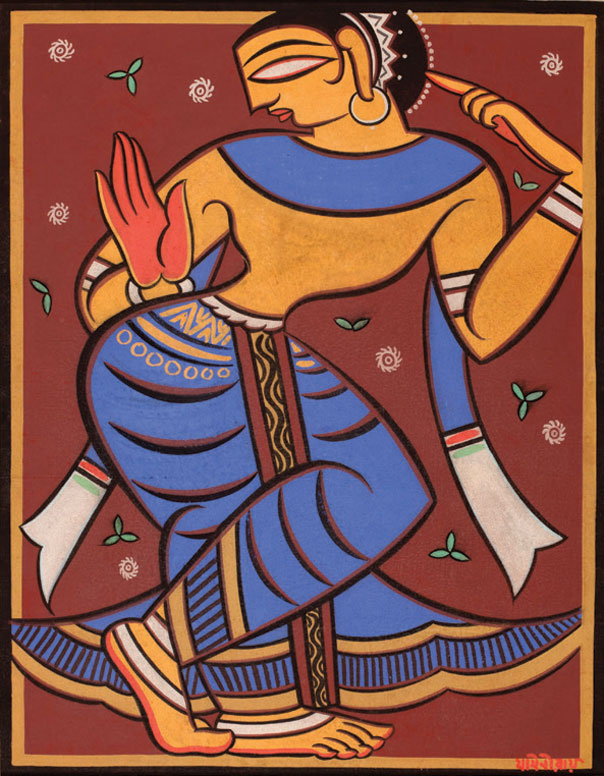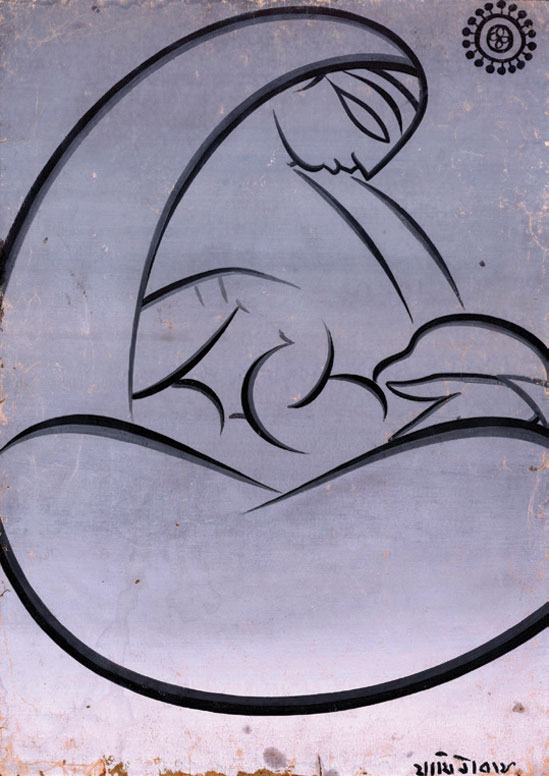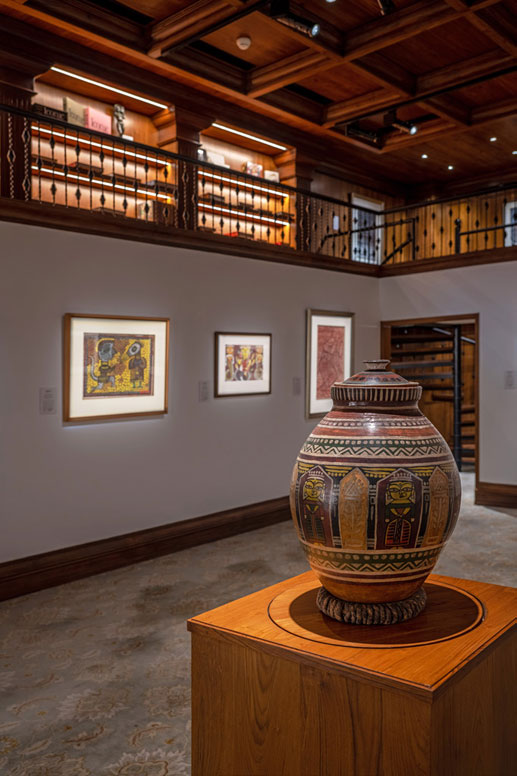Ballygunge Calling
Jamini Roy’s home in Kolkata will soon become a gallery to preserve the artist’s legacy
 Shaikh Ayaz
Shaikh Ayaz
 Shaikh Ayaz
Shaikh Ayaz
 |
05 May, 2023
|
05 May, 2023
/wp-content/uploads/2023/05/Ballygunge1.jpg)
Jamini Roy in his studio, Kolkata (Courtesy: DAG)
“Bengalis love their Tagores, their machher jhols and well, their Jamini Roys,” exclaims Kishore Singh, head of content, DAG, sounding ecstatic about the prospect of Jamini Roy’s Ballygunge Place home-cum-studio in Kolkata soon becoming a museum, thanks to DAG’s continuing effort to preserve Roy’s heritage. It won’t be an exaggeration to argue that Jamini Roy stands tall in the Bengal renaissance, even when compared to the towering figures of his time, such as Abanindranath Tagore, Nandalal Bose, Sunayani Devi and the legendary Rabindranath Tagore himself. “One certainly cannot downplay Jamini Roy’s importance in the Indian modernist canon,” remarks Singh. “There’s something endearing about his art. It appeals to everyone, whether you are a young child, an adult or a senior citizen. He speaks directly to the people, often utilising simple folk motifs and that’s what makes his work so universal and popular.”
Since its inception in 1993, DAG has been devoted to Bengali art, a passion that has only “grown stronger with time,” Singh notes. The gallery’s commitment to the Bengal School, in particular, was best exemplified by its multi-year exhibition Ghare Baire. Held at the historic Currency Building in Kolkata between 2019 and 2021, it provided a glimpse into Bengali art and the emergence of modern Indian art through a collection of 700 works, dating from the 18th to 20th century. Roy was one of the featured artists in Ghare Baire, a show that Ashish Anand, CEO and managing director of DAG, describes as “a source of pride” for the country. “Kolkata/Bengal have been the crucible, which saw the birth of modern art movements and art being used as resistance against colonial hegemony drowning out Indian ideas and contexts,” Anand explains. When he heard that the Jamini Roy house was going on the block, he couldn’t resist reaching out to the family. An avid collector of Roy’s works, his fascination with the artist began back in 1999, with his first acquisition of a Roy work from Russi Mody of the Tata Group. “He is everyone’s favourite or first buy, perhaps even more so than MF Husain,” Anand says, pointing out that the creation of the Jamini Roy House Museum, due to open next year, represents the culmination of DAG’s attempts to promote the artist’s legacy.

No artist, Anand contends, is more deserving of a dedicated museum than Roy, who belongs to the rare category of Indian masters whose works have been declared a ‘national treasure’ under the Antiquities and Art Treasures Act, 1972. Roy’s three-storey house in Ballygunge Place was relatively unassuming in its heyday. As the conservation and restoration efforts commence, Anand admits that the primary objective is to “maintain the integrity of the space.” It is believed that the artist moved from the congested Baghbazar neighbourhood in North Calcutta to Ballygunge Place, which was an emerging residential suburb in the late 1940s. He bought three plots of land on which he initially constructed a single-storey house. “But as his family kept growing and needed to be accommodated, he added two more floors,” says Anand. While his studio remained on the ground floor, where he usually sat on a mat on the floor and worked long hours, the first and second levels served as private spaces for the family and could be accessed through a separate staircase. Roy lived in the Ballygunge Place home till his death at the age of 85 in 1972.
Jamini Roy’s three-storey house in Ballygunge place was relatively unassuming in its heyday. As the conservation and restoration efforts commence, the primary objective is to maintain the integrity of the space
The younger members of the Roy clan grew up on the stories surrounding the family house and its inhabitants. Arkamitra Roy, the artist’s great granddaughter, learnt about family lore from her mother. “One of the favourite memories of the house is the way festivals were celebrated there,” says Arkamitra, who is a photographer based in Kolkata. “Everyone was invited. Noboborsho, Dol, Kali Pujo and Bhai Phonta were four festivals that everyone looked forward to. The house would be beautifully decorated and forbidden foods like shingara and sharbat would be allowed in small quantities to the children. On Maha Sashti, the sixth day of Durga Puja, Jamini Roy would visit the clothing store Gouranga Bastralaya to buy dhotis and saris for every friend and acquaintance.”
The house was modest, but not ordinary. “For Jamini Roy’s admirers, it was like a place of pilgrimage,” says Singh, pointing out that a cottage industry had sprouted around the Bengali artist. “One family anecdote goes that the children would come home from school only to find their street barricaded, as the artist was most likely entertaining a VIP visitor.” Between his rented dwelling in Baghbazar and new home in Ballygunge Place, Roy regularly hosted a litany of local and global celebrities, such as Rabindranath Tagore, novelist EM Forster and Russian film director Vsevolod Pudovkin, to name a few.

Yet, despite the steady stream of guests and patrons, Arkamitra says that her great grandfather managed to focus on his work as the Ballygunge Place home was “a perfect place for an artist who valued his peace and quiet.” Adjacent to Roy’s ground floor studio was a room, which also functioned as a gallery, from where patrons could buy works directly from the artist. “Though he was highly sought after he made sure that the prices of his paintings were reasonable, so that all sections of the masses could afford them,” says Singh. “People liked his themes and wanted to beautify their homes with it. Today, every middle-class Bengali home has a Jamini Roy print. His work takes pride of place all across India, but especially if you ask Bengalis they will say that owning a Jamini Roy is almost like a way of life for them.”
Born in 1887 to a landowning family in Bankura district in West Bengal, Roy began his artistic journey at 16 when he enrolled at the Government School of Arts and Crafts in Calcutta. Roy’s talent flourished under the tutelage of his teacher Abanindranath Tagore and he swiftly gained proficiency in the prevailing style— orientalism. At first, he resorted to accepting portrait commissions to make ends meet and even dabbled in post-Impressionist landscapes that were reminiscent of Vincent van Gogh. Eventually, he abandoned it for the art of primitive purity. “Abanindranath was encouraging his students to adopt a more orientalist approach, yet Roy stood his ground and went on to create a highly distinctive style. This couldn’t have been easy. Though he came from a zamindar family it was clear that he needed to make his own living,” Singh explains. Arkamitra acknowledges that, despite achieving tremendous success during his lifetime, Roy’s life was not without its share of challenges. “It was decades before he enjoyed any form of success,” she says. The family faced financial hardships and overcame with the unflinching support of Roy’s wife Anandamoyee Roy.

Over time, Roy has developed a reputation as the doyen of folk art. MF Husain hailed him as the “father of Indian modern art.” Roy pioneered a remarkable painterly idiom characterised by simplified forms and composition, bold and expressive outlines and an earthy colour palette. His visual language is so strikingly original that it is singular. Perhaps, Roy’s most significant contribution to the development of Indian modern art is how he inspired and empowered succeeding generations of artists to borrow from their own cultural roots. (One of them was Husain, who embraced folk art in his own quest for modernism.) Roy strongly believed that genuine art could only originate from one’s soil. Thus, he gave stylistic interpretation to vernacular sources such as the Bishnupur terracotta temple friezes, Kalighat patuas (scroll painting), and wooden clay toys from village haats. Having rejected oil painting, he settled on tempera, a water-based pigment thicker than watercolour. Most of his famous works were made using this indigenous material, once again a reminder of his admiration for village artisans and their skilled craftsmanship. Singh says that his goal was to make art for the common people and not necessarily for the elite. “Here was someone who felt middle-class homes were the right destination for his creations. Therefore, he worked with the most reasonable material available such as tempera on wood or cardboard so that his paintings remained very much affordable.”
Many of Roy’s iconic creations depicted mythological and religious scenes, including Hindu and Christian legends. He also turned to the Santhal communities and their extraordinary music and dance traditions. Again and again, he returned to the themes of women and motherhood. “Whether portraying Yashoda and Krishna or Mother and Child, you find the same evocative power and purity of spirit,” says Singh. Some scholars suggest that he may have familiarised himself with Byzantine art through books or catalogues, as evidenced by some unusually experimental works bearing a mosaic-like vitality. DAG’s Mumbai gallery is currently showcasing a collection of 21 paintings by the artist entitled Living Traditions and the Art of Jamini Roy. Here one can see many of Roy’s iconic works including the almond-eyed women.

Helmed by Abanindranath Tagore and his brother Gaganendranath Tagore, the ‘Bengal School’ was the leading movement of the early 20th century whose enduring vision continues to guide artists in Kolkata and Santiniketan even today. Though Roy shared the nationalist ethos of the Bengal School he departed from the movement’s central tenet, which prioritised the revival of Mughal and Rajput artistic traditions. As author Partha Mitter notes in his book The Triumph of Modernism, there appeared to be some differences between Roy and his contemporary Nandalal Bose, who was also a disciple of Abanindranath Tagore. So, while Bose went on to pursue his own Gandhian practice and pedagogy in Santiniketan, Roy remained in Calcutta, serving up his idealised rural utopia to an expanding urban audience. One wonders if Bose felt betrayed by Roy’s mass-produced commercial images, or viewed him simply as a lost cause. Singh reckons that each of these artists had their own unique journeys, driven by a quest for their origins. “While Abanindranath Tagore delved into the past, Jamini Roy focused on the present and his surroundings, and Rabindranath Tagore explored both his environment and his inner self. I think these were the distinctions they were trying to make in their practices. And Nandalal Bose was like a sutradhar segueing their different worlds and sensibilities, bridging history with the subaltern,” Singh says, before adding, “In this creative environment, Jamini Roy’s unique contribution lay in his belief and conviction that any art must ultimately draw from the very soil that nurtured him. This, eventually, is what sets him and his art apart from all other Indian artists.”
(The Jamini Roy House Museum will open in Kolkata next year. Living Traditions and the Art of Jamini Roy is on display at DAG, Mumbai till May 16)
About The Author
MOst Popular
3

/wp-content/uploads/2025/07/Cover_Crashcause.jpg)












More Columns
Bihar: On the Road to Progress Open Avenues
The Bihar Model: Balancing Governance, Growth and Inclusion Open Avenues
Caution: Contents May Be Delicious V Shoba